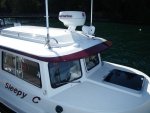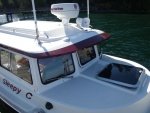Need some help deciding on fixed and handheld VHF radios.
I was originally keeping everything in the Garmin family, but on sage advice I'm going with a radio company for the radio.
Some of the Icom and Standard Horizon models have current rebates, so that might be a nice timing bonus.
FIXED AIS/GPS VHF:
------------------
Icom M506, AIS/GPS, NMEA 2000, 2 minute last call recording
$600 - West Marine
$454 - Ultimate Passage
Standard Horizon GX2200, AIS/GPS, NMEA 0183
$400 - $40 rebate = $350 - West Marine
$320 - $40 rebate = $280 - Ultimate Passage
The main difference seems to be the NMEA 2000 connectivity and the 2 minute last call recording feature.
Is this worth the $174-250 premium, and why?
FIXED GPS only VHF:
--------------
Icom M424G, GPS
$300 - $30 rebate = $270 - West Marine
$240 - $30 rebate = $214 - Ultimate Passage
Standard Horizon GX1700, GPS
$250 - $30 rebate = $220 - West Marine
$203 - $30 rebate = $173 - Ultimate Passage
Is AIS a useful enough function for FL/Bahamas cruising that I should consider it or not?
If so, is it worth the extra boat unit for a dedicated Tx/Rx?
We don't plan to cruise at night or in fog, but man makes plans and God laughs.
HANDHELD VHF:
-------------
Icom M93D, GPS/DSC
$300 - $30 rebate = $270 - West Marine
$240 - $30 rebate = $210 - Ultimate Passage
Standard Horizon HX870, GPS/DSC
$200 - $40 rebate = $160 - West Marine
$205 - $40 rebate = $165 - Ultimate Passage
The plan is to have one fixed in cabin and one handheld in ditch bag.
Does this sound about right for off-shore Florida cruising?
Is there anything else I should be considering in a VHF?
I was originally keeping everything in the Garmin family, but on sage advice I'm going with a radio company for the radio.
Some of the Icom and Standard Horizon models have current rebates, so that might be a nice timing bonus.
FIXED AIS/GPS VHF:
------------------
Icom M506, AIS/GPS, NMEA 2000, 2 minute last call recording
$600 - West Marine
$454 - Ultimate Passage
Standard Horizon GX2200, AIS/GPS, NMEA 0183
$400 - $40 rebate = $350 - West Marine
$320 - $40 rebate = $280 - Ultimate Passage
The main difference seems to be the NMEA 2000 connectivity and the 2 minute last call recording feature.
Is this worth the $174-250 premium, and why?
FIXED GPS only VHF:
--------------
Icom M424G, GPS
$300 - $30 rebate = $270 - West Marine
$240 - $30 rebate = $214 - Ultimate Passage
Standard Horizon GX1700, GPS
$250 - $30 rebate = $220 - West Marine
$203 - $30 rebate = $173 - Ultimate Passage
Is AIS a useful enough function for FL/Bahamas cruising that I should consider it or not?
If so, is it worth the extra boat unit for a dedicated Tx/Rx?
We don't plan to cruise at night or in fog, but man makes plans and God laughs.
HANDHELD VHF:
-------------
Icom M93D, GPS/DSC
$300 - $30 rebate = $270 - West Marine
$240 - $30 rebate = $210 - Ultimate Passage
Standard Horizon HX870, GPS/DSC
$200 - $40 rebate = $160 - West Marine
$205 - $40 rebate = $165 - Ultimate Passage
The plan is to have one fixed in cabin and one handheld in ditch bag.
Does this sound about right for off-shore Florida cruising?
Is there anything else I should be considering in a VHF?



